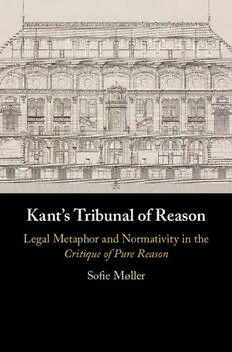
Kant's Tribunal of Reason: Legal Metaphor and Normativity in the Critique of Pure Reason PDF
Preview Kant's Tribunal of Reason: Legal Metaphor and Normativity in the Critique of Pure Reason
KANT’S TRIBUNAL OF REASON Kant’sCritiqueofPureReason,hismainworkoftheoreticalphiloso- phy, frequently uses metaphors from law. In this first book-length studyinEnglishofKant’slegalmetaphorsandtheirroleinthefirst Critique,SofieMøllershowsthattheyarecentraltoKant’saccountof reason.Throughananalysisofthelegalmetaphorsintheirentirety, shedemonstratesthatKantconceivesofreasonashavingastructure mirroring that of a legal system in a natural right framework. Her studyshowsthatKant’saimistomakecognisersbecomesimilarto authorisedjudgeswithinsuchasystem,byprovingthelegitimacyof the laws and the conditions under which valid judgements can be pronounced.Theseelementsconsolidateherconclusionthatreason’s systematicityislegalsystematicity. sofie møller is a research associate in philosophy at Goethe UniversityFrankfurt. (cid:19)(cid:6)(cid:12)(cid:11)(cid:17)(cid:10)(cid:8)(cid:7)(cid:1)(cid:15)(cid:14)(cid:12)(cid:11)(cid:14)(cid:8)(cid:1)(cid:6)(cid:21)(cid:1)(cid:2)(cid:5)(cid:13)(cid:6)(cid:16)(cid:11)(cid:7)(cid:9)(cid:8)(cid:1)(cid:4)(cid:14)(cid:11)(cid:20)(cid:8)(cid:16)(cid:17)(cid:11)(cid:18)(cid:21)(cid:1) (cid:16)(cid:8)(cid:17)(cid:17) (cid:19)(cid:6)(cid:12)(cid:11)(cid:17)(cid:10)(cid:8)(cid:7)(cid:1)(cid:15)(cid:14)(cid:12)(cid:11)(cid:14)(cid:8)(cid:1)(cid:6)(cid:21)(cid:1)(cid:2)(cid:5)(cid:13)(cid:6)(cid:16)(cid:11)(cid:7)(cid:9)(cid:8)(cid:1)(cid:4)(cid:14)(cid:11)(cid:20)(cid:8)(cid:16)(cid:17)(cid:11)(cid:18)(cid:21)(cid:1) (cid:16)(cid:8)(cid:17)(cid:17) KANT’S TRIBUNAL OF REASON Legal Metaphor and Normativity in the Critique of Pure Reason SOFIE MØLLER GoetheUniversityFrankfurt (cid:19)(cid:6)(cid:12)(cid:11)(cid:17)(cid:10)(cid:8)(cid:7)(cid:1)(cid:15)(cid:14)(cid:12)(cid:11)(cid:14)(cid:8)(cid:1)(cid:6)(cid:21)(cid:1)(cid:2)(cid:5)(cid:13)(cid:6)(cid:16)(cid:11)(cid:7)(cid:9)(cid:8)(cid:1)(cid:4)(cid:14)(cid:11)(cid:20)(cid:8)(cid:16)(cid:17)(cid:11)(cid:18)(cid:21)(cid:1) (cid:16)(cid:8)(cid:17)(cid:17) UniversityPrintingHouse,Cambridgecb28bs,UnitedKingdom OneLibertyPlaza,20thFloor,NewYork,ny10006,USA 477WilliamstownRoad,PortMelbourne,vic3207,Australia 314–321,3rdFloor,Plot3,SplendorForum,JasolaDistrictCentre, NewDelhi–110025,India 79AnsonRoad,#06–04/06,Singapore079906 CambridgeUniversityPressispartoftheUniversityofCambridge. ItfurtherstheUniversity’smissionbydisseminatingknowledgeinthepursuitof education,learning,andresearchatthehighestinternationallevelsofexcellence. www.cambridge.org Informationonthistitle:www.cambridge.org/9781108498494 doi:10.1017/9781108682480 ©SofieMøller2020 Thispublicationisincopyright.Subjecttostatutoryexception andtotheprovisionsofrelevantcollectivelicensingagreements, noreproductionofanypartmaytakeplacewithoutthewritten permissionofCambridgeUniversityPress. Firstpublished2020 PrintedintheUnitedKingdombyTJInternationalLtd,PadstowCornwall AcataloguerecordforthispublicationisavailablefromtheBritishLibrary. LibraryofCongressCataloging-in-PublicationData names:Møller,Sofie,author. title:Kant’stribunalofreason:legalmetaphorandnormativityintheCritiqueofpurereason/ SofieMøller,Goethe-UniversitätFrankfurtAmMain. description:Cambridge,UnitedKingdom;NewYork,NY,USA:CambridgeUniversity Press,2020.|Includesbibliographicalreferencesandindex. identifiers:lccn2019044319(print)|lccn2019044320(ebook)|isbn9781108498494 (hardback)|isbn9781108682480(ebook) subjects:lcsh:Kant,Immanuel,1724–1804.KritikderpraktischenVernunft.|Ethics.| Judgment(Ethics)|Practicalreason.|Law(Philosophicalconcept) classification:lccb2774.m652020(print)|lccb2774(ebook)|ddc121–dc23 LCrecordavailableathttps://lccn.loc.gov/2019044319 LCebookrecordavailableathttps://lccn.loc.gov/2019044320 isbn978-1-108-49849-4Hardback CambridgeUniversityPresshasnoresponsibilityforthepersistenceoraccuracyof URLsforexternalorthird-partyinternetwebsitesreferredtointhispublication anddoesnotguaranteethatanycontentonsuchwebsitesis,orwillremain, accurateorappropriate. (cid:19)(cid:6)(cid:12)(cid:11)(cid:17)(cid:10)(cid:8)(cid:7)(cid:1)(cid:15)(cid:14)(cid:12)(cid:11)(cid:14)(cid:8)(cid:1)(cid:6)(cid:21)(cid:1)(cid:2)(cid:5)(cid:13)(cid:6)(cid:16)(cid:11)(cid:7)(cid:9)(cid:8)(cid:1)(cid:4)(cid:14)(cid:11)(cid:20)(cid:8)(cid:16)(cid:17)(cid:11)(cid:18)(cid:21)(cid:1) (cid:16)(cid:8)(cid:17)(cid:17) But if reason has to be criticised, by whom can it be done? By no-one but itself, thus it is both defendant and judge. And according to what can it be judged? Only according to itself; thus it is also law and witness. The difficulties of this judgeship are immediately evident. (JohannGottfriedHerder,AMetacritiqueontheCritique of Pure Reason) (cid:19)(cid:6)(cid:12)(cid:11)(cid:17)(cid:10)(cid:8)(cid:7)(cid:1)(cid:15)(cid:14)(cid:12)(cid:11)(cid:14)(cid:8)(cid:1)(cid:6)(cid:21)(cid:1)(cid:2)(cid:5)(cid:13)(cid:6)(cid:16)(cid:11)(cid:7)(cid:9)(cid:8)(cid:1)(cid:4)(cid:14)(cid:11)(cid:20)(cid:8)(cid:16)(cid:17)(cid:11)(cid:18)(cid:21)(cid:1) (cid:16)(cid:8)(cid:17)(cid:17) (cid:19)(cid:6)(cid:12)(cid:11)(cid:17)(cid:10)(cid:8)(cid:7)(cid:1)(cid:15)(cid:14)(cid:12)(cid:11)(cid:14)(cid:8)(cid:1)(cid:6)(cid:21)(cid:1)(cid:2)(cid:5)(cid:13)(cid:6)(cid:16)(cid:11)(cid:7)(cid:9)(cid:8)(cid:1)(cid:4)(cid:14)(cid:11)(cid:20)(cid:8)(cid:16)(cid:17)(cid:11)(cid:18)(cid:21)(cid:1) (cid:16)(cid:8)(cid:17)(cid:17) Contents Acknowledgements pageix ListofAbbreviations xi Introduction 1 TheCognitiveFunctionofMetaphors 5 MethodologicalConsiderations 8 ThePrimacyofPracticalReasonandEpistemicNormativity 10 OutlineoftheBook 13 1 TheCritiqueofPureReasonastheEstablishment ofReason’sLawfulCondition 16 TheCritiqueofPureReasonasaReviewofLaws 17 TheNaturalRightTraditionandtheNaturrechtFeyerabend 20 TheCritiqueofPureReasonasaLawfulSolutiontoConflicts 22 EstablishingaRightfulCondition 27 2 TheNormativityofLaw 32 NaturalRightandPositiveLaw 33 LawsofNatureintheNaturalSciences 37 APrioriLawsasObjectivelyValidRules 40 LawsandPrinciples 40 UnderstandingasPrescribingLawstoNature 43 3 TheTranscendentalDeductionoftheCategories andtheTraditionofLegalDeductions 52 QuidJurisandtheTranscendentalDeductionoftheCategories 53 TheAnalogybetweenConceptsandProperty 55 TheTranscendentalDeductionoftheCategoriesasaLegal DeductionTracinganOrigin 58 TheTraditionofLegalDeductions 62 4 TheQuestionofFactandtheQuestionofLawinJudicial ImputationandintheTranscendentalDeduction oftheCategories 65 vii (cid:19)(cid:6)(cid:12)(cid:11)(cid:17)(cid:10)(cid:8)(cid:7)(cid:1)(cid:15)(cid:14)(cid:12)(cid:11)(cid:14)(cid:8)(cid:1)(cid:6)(cid:21)(cid:1)(cid:2)(cid:5)(cid:13)(cid:6)(cid:16)(cid:11)(cid:7)(cid:9)(cid:8)(cid:1)(cid:4)(cid:14)(cid:11)(cid:20)(cid:8)(cid:16)(cid:17)(cid:11)(cid:18)(cid:21)(cid:1) (cid:16)(cid:8)(cid:17)(cid:17) viii Contents QuidFactiandtheTracingofanOrigin 65 QuidFactiandtheMetaphysicalDeductionoftheCategories 66 TheQuestionofFactandtheQuestionofLawinJudicialImputation 69 TheTranscendentalDeductionoftheCategoriesasJudicialImputation 74 5 TheTribunalofReason 81 TheCritiqueofPureReasonasTribunal 81 AntinomyofPureReasonasaLegalTrial 86 EmpiricalExperienceasTestimony 87 TheReaderasJudgeoftheCritiqueofPureReason 89 TheOutcomeoftheCritiqueofPureReasonasVerdict 93 6 MoralConscienceasthePracticalInnerTribunal 96 ConscienceasanInnerTribunal 98 Self-deceptioninMoralConscience 104 TheProblemofanErringConscience 106 ParallelsbetweenMoralConscienceandtheCritiqueofPureReason 109 7 DistinguishingbetweenRightfulClaimsandGroundless Pretensions 113 HistoricalBackgroundonJudicialAuthority 114 KantonJudicialAuthority 117 TheJudicialOfficeintheLegalMetaphors 121 AuthorityandValidityofJudgementsandInferences 123 8 EpistemicAuthorityasbothIndividualandCollectivelyShared 129 DecreesastheOppositeofVerdicts 129 CognitiveAttitudes 132 EpistemicAuthorityandtheThinkingSelf 134 PoliticalAspectsoftheCritiqueofPureReason 139 TheCommunityofCognisers 145 9 SystematicityandPhilosophyastheLegislationofReason 152 OtherImagesofSystematicity:TheOrganismandtheBuilding 153 LegalMetaphorsasIllustrationsofSystematicity 159 PhilosophyastheLegislationofHumanReason 161 SystematicityintheAppendixtotheTranscendentalDialectic 163 TheCritiqueofPureReasonasaScienceoftheLawsofPureReason 167 Conclusion 170 Bibliography 174 Index 194 (cid:19)(cid:6)(cid:12)(cid:11)(cid:17)(cid:10)(cid:8)(cid:7)(cid:1)(cid:15)(cid:14)(cid:12)(cid:11)(cid:14)(cid:8)(cid:1)(cid:6)(cid:21)(cid:1)(cid:2)(cid:5)(cid:13)(cid:6)(cid:16)(cid:11)(cid:7)(cid:9)(cid:8)(cid:1)(cid:4)(cid:14)(cid:11)(cid:20)(cid:8)(cid:16)(cid:17)(cid:11)(cid:18)(cid:21)(cid:1) (cid:16)(cid:8)(cid:17)(cid:17) Acknowledgements Whatdoespurereasonhavetodowithlawsandtribunals?Ihavepuzzled over this question for years and have been fortunate to be encouraged, helpedandchallengedbymanypeoplealongtheway.OftheseIwouldlike tomentionthefollowinginparticular. I am grateful to Dennis Patterson for guiding my research on law and legal philosophy. His guidance helped me understand the intricacies of legalthoughtandthewaysinwhicheventoday’slawyersandlegaltheorists are indebted to Kant’s metaphors. I thank Paul Guyer for hosting my research stay at Brown University and for his invaluable support in my inquiryintotheCritiqueofPureReason.IthankNehalBhutaforhelping meunderstandthehistoryofnaturalrightandforsupportingthisproject from the very beginning. To Marcus Willaschek, I am grateful for his comments on an early version of the manuscript and for his continued academic generosity. I am thankful to Rainer Forst for supporting and furtheringmyinquiryintometaphoricalandactualnormativeorders. This work has greatly benefited from insightful comments and sugges- tions from many friends and colleagues. Of these, I especially thank: Reinhard Brandt, Andrew Chignell, Ilaria Cozzaglio, Ruhi Demiray, Gabriele Gava, Dieter Henrich, Hansmichael Hohenegger, Rolf-Peter Horstmann, Jakob Huber, Katharina Kraus, Luigi Filieri, Michael Forster, Colin J. Mcquillan, Reidar Maliks, Alice Pinheiro-Walla, Konstantin Pollok, Riccardo Pozzo, Ariel Zylberman, my colleagues at the Cluster of Excellence ‘The Formation of Normative Orders’ and the membersoftheFrankfurterKant-Arbeitskreis. IamindebtedtoLeoCatanaforguidingmyfirststepsintothehistoryof philosophyandtoCostantinoMarmoforintroducingmetotheworldof semiotics and for encouraging my inquiry into the history of metaphors, symbolsandanalogies. I thank the two anonymous readers at Cambridge University Press for their helpful suggestions on the manuscript and Hilary Gaskin, Sophie ix (cid:19)(cid:6)(cid:12)(cid:11)(cid:17)(cid:10)(cid:8)(cid:7)(cid:1)(cid:15)(cid:14)(cid:12)(cid:11)(cid:14)(cid:8)(cid:1)(cid:6)(cid:21)(cid:1)(cid:2)(cid:5)(cid:13)(cid:6)(cid:16)(cid:11)(cid:7)(cid:9)(cid:8)(cid:1)(cid:4)(cid:14)(cid:11)(cid:20)(cid:8)(cid:16)(cid:17)(cid:11)(cid:18)(cid:21)(cid:1) (cid:16)(cid:8)(cid:17)(cid:17) x Acknowledgements Taylor and Hal Churchman at Cambridge University Press for their editorialassistance. IhavepresentedthematerialbehindthisbooktoaudiencesinFrankfurt, Berlin,Mainz,Marburg,Providence,Oxford,Keele,York,Florence,Pisa, Copenhagen, Roskilde and Oslo and I am grateful to the participants at theseeventsfortheirthoughtsandsuggestions. Finally, I thank my husband Pablo Karaman for his unfailing encour- agementandsupport. (cid:19)(cid:6)(cid:12)(cid:11)(cid:17)(cid:10)(cid:8)(cid:7)(cid:1)(cid:15)(cid:14)(cid:12)(cid:11)(cid:14)(cid:8)(cid:1)(cid:6)(cid:21)(cid:1)(cid:2)(cid:5)(cid:13)(cid:6)(cid:16)(cid:11)(cid:7)(cid:9)(cid:8)(cid:1)(cid:4)(cid:14)(cid:11)(cid:20)(cid:8)(cid:16)(cid:17)(cid:11)(cid:18)(cid:21)(cid:1) (cid:16)(cid:8)(cid:17)(cid:17)
